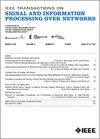Information Fusion via Importance Sampling
IF 3
3区 计算机科学
Q2 ENGINEERING, ELECTRICAL & ELECTRONIC
IEEE Transactions on Signal and Information Processing over Networks
Pub Date : 2023-08-07
DOI:10.1109/TSIPN.2023.3299512
引用次数: 0
Abstract
Information fusion is a procedure that merges information locally contained at the nodes of a network. Of high interest in the field of distributed estimation is the fusion of local probability distributions via a weighted geometrical average criterion. In numerous practical settings, the local distributions are only known through particle approximations, i.e., sets of samples with associated weights, such as obtained via importance sampling (IS) methods. Thus, prohibiting any closed-form solution to the aforementioned fusion problem. This article proposes a family of IS methods—called particle geometric–average fusion (PGAF)—that lead to consistent estimators for the geometrically-averaged density. The advantages of the proposed methods are threefold. First, the methods are agnostic of the mechanisms used to generate the local particle sets and, therefore, allow for the fusion of heterogeneous nodes. Second, consistency of estimators is guaranteed under generic conditions when the agents use IS-generated particles. Third, a low-communication overhead and agent privacy are achieved since local observations are not shared with the fusion center. Even more remarkably, for a sub-family of the proposed PGAF methods, the fusion center does not require the knowledge of the local priors used by the nodes. Implementation guidelines for the proposed methods are provided and theoretical results are numerically verified.通过重要度采样进行信息融合
信息融合是一种将网络节点所包含的局部信息进行合并的程序。在分布式估算领域,通过加权几何平均准则对局部概率分布进行融合的方法备受关注。在许多实际环境中,局部分布只能通过粒子近似值(即具有相关权重的样本集,如通过重要性采样 (IS) 方法获得)来获知。因此,上述融合问题无法得到任何闭合形式的解决方案。本文提出了一系列称为粒子几何平均融合(PGAF)的 IS 方法,这些方法可以得到一致的几何平均密度估计值。所提方法有三方面的优势。首先,这些方法与生成局部粒子集的机制无关,因此允许异构节点融合。其次,当代理使用 IS 生成的粒子时,在一般条件下可保证估计器的一致性。第三,由于不与融合中心共享本地观测数据,因此实现了低通信开销和代理隐私。更值得注意的是,对于所提出的 PGAF 方法的一个子系列,融合中心并不需要知道节点所使用的本地先验。本文提供了拟议方法的实施指南,并对理论结果进行了数值验证。
本文章由计算机程序翻译,如有差异,请以英文原文为准。
求助全文
约1分钟内获得全文
求助全文
来源期刊

IEEE Transactions on Signal and Information Processing over Networks
Computer Science-Computer Networks and Communications
CiteScore
5.80
自引率
12.50%
发文量
56
期刊介绍:
The IEEE Transactions on Signal and Information Processing over Networks publishes high-quality papers that extend the classical notions of processing of signals defined over vector spaces (e.g. time and space) to processing of signals and information (data) defined over networks, potentially dynamically varying. In signal processing over networks, the topology of the network may define structural relationships in the data, or may constrain processing of the data. Topics include distributed algorithms for filtering, detection, estimation, adaptation and learning, model selection, data fusion, and diffusion or evolution of information over such networks, and applications of distributed signal processing.
 求助内容:
求助内容: 应助结果提醒方式:
应助结果提醒方式:


